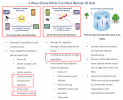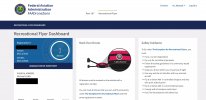This isn't commercial in the sense of drone delivery which is an entirely different part 135. Intent may have something with most laws, but I really don't understand what intent of flight has to do with drone regulations.I'm one of those ones who use the images from my mini-2 for commercial purposes. I do not do business that requires clients to hire me but I do take some wicked good "art" photographs (attached is Long Pond in Belvidere Vermont) And because I have this up for sale, this mission is a part 107 mission. EVERY mission I take off with the mini 2 is a Part 107 because while it is wildly FUN to fly... IT IS NOT a recreational flight because my intent is to make a dollar or two from my images... So this summer (2023) I am looking at buying a Mavic 3 (some variant) so RID will be built in. I simply do not want to buy a 200-300$ add-on just to be able to use my images for sales.
You are using an out of date browser. It may not display this or other websites correctly.
You should upgrade or use an alternative browser.
You should upgrade or use an alternative browser.
Remote ID sub 250g used for rec and 107
- Thread starter 66427cobra
- Start date
ScottTX
Well-Known Member
Something else that I noticed, the difference between the details of what a Drone with built-in "Standard Remote ID Drones" & a "Remote ID Broadcast Module" equipped Drone:
So for example, is a Drone with a built-in module not subject to VLS?
What about Control Station Location and Elevation?
What about Emergency Status?

So for example, is a Drone with a built-in module not subject to VLS?
What about Control Station Location and Elevation?
What about Emergency Status?

Last edited:
Supposedly the built in module will be compliant for when they allow bvlos whereas the others won't. What difference that makes I don't know. Somebody just went to sleep and woke up. Eureka! Remote id is the solution in need of a problem. Let's get the faa to strong arm everyone into having to have it in order to operate.Something else that I noticed, the difference between the details of what a Drone with built-in "Standard Remote ID Drones" & a "Remote ID Broadcast Module" equipped Drone:
So for example, is a Drone with a built-in module not subject to VLS?
What about Control Station Location and Elevation?
What about Emergency Status?
View attachment 163010
Arnold LeVine
Well-Known Member
Would you like the Reader's Digest compressed version? It's 15 pages longer and still doesn't make it any easier to understand. They scrambled to get some rules slapped together and now it makes no sense to anyone. One size fits nothing.Thank God these FAA drone rules are so concise and easy to understand and comply with.
- Joined
- Oct 17, 2020
- Messages
- 1,215
- Reactions
- 897
- Age
- 44
- Location
- Grand Rapids, MI
- Site
- karlblessing.com
Drones with native remote ID will be eligible for BVLOS waivers as mentioned before. Doesn't mean that VLOS rules don't apply, just that simply put, you can apply for a waiver. You can't get a waiver for BVLOS with an attached RID module type of compliance.Something else that I noticed, the difference between the details of what a Drone with built-in "Standard Remote ID Drones" & a "Remote ID Broadcast Module" equipped Drone:
So for example, is a Drone with a built-in module not subject to VLS?
What about Control Station Location and Elevation?
What about Emergency Status?
I don't understand what the remote ID module provides that allows for BVLOS. It misses any function to provide that, as being it is only for LEOs to identify a drone, but not for BVLOS flight.Drones with native remote ID will be eligible for BVLOS waivers as mentioned before. Doesn't mean that VLOS rules don't apply, just that simply put, you can apply for a waiver. You can't get a waiver for BVLOS with an attached RID module type of compliance.
Arnold LeVine
Well-Known Member
Sorry you missed my sarcasmWould you like the Reader's Digest compressed version? It's 15 pages longer and still doesn't make it any easier to understand. They scrambled to get some rules slapped together and now it makes no sense to anyone. One size fits nothing.
No I got it...Sorry you missed my sarcasm
A compressed version being longer than the original? LOL
- Joined
- Oct 17, 2020
- Messages
- 1,215
- Reactions
- 897
- Age
- 44
- Location
- Grand Rapids, MI
- Site
- karlblessing.com
Native RemoteID can provide live update of the drone's status as well as the pilot's position. RID Module doesn't know what the status of the drone is, and only knows the take off position of the drone but not the up to date controller position.I don't understand what the remote ID module provides that allows for BVLOS. It misses any function to provide that, as being it is only for LEOs to identify a drone, but not for BVLOS flight.
So if for example a drone is flying a few miles away, doing something it shouldn't, they would have a live position of the pilot itself, not just where they took off from. (they don't know if you're BVLOS or not if you're using a module, so if you're not within the immediate vicinity, you are likely flying BVLOS).
It's probably setting up for the eventual push for networked remote ID.
They started off with Network Remote ID, and some countries are still going to go with that, but here in the states, it got shot down for logistical reasons. And when you think about it, if you're out in the middle of nowhere where there is no cell coverage, you most likely don't need to call in. There's nothing out there, but because they couldn't get network remote ID, they want broadcast to broadcast everywhere regardless. So, no it really isn't necessary to have network remote ID, there wasn't enough reason for it anyhow. It's another one of those bite my tongue to spite my face situations, as government typically doesn't use a reasonable approach to everything. They just want non stop surveillance on all activities all the time without a court ordered warrant. As if it is going to deter crime.Native RemoteID can provide live update of the drone's status as well as the pilot's position. RID Module doesn't know what the status of the drone is, and only knows the take off position of the drone but not the up to date controller position.
So if for example a drone is flying a few miles away, doing something it shouldn't, they would have a live position of the pilot itself, not just where they took off from. (they don't know if you're BVLOS or not if you're using a module, so if you're not within the immediate vicinity, you are likely flying BVLOS).
It's probably setting up for the eventual push for networked remote ID.
But Remote ID wasn't created with BVLOS in mind, and they need scrap remote ID until they get the security and safety actually into focus as the purpose of requiring it in the first place. It's a waste of money in the current implementation IMHO. The government has deviated from the rules to push more draconian measures.
- Joined
- Oct 17, 2020
- Messages
- 1,215
- Reactions
- 897
- Age
- 44
- Location
- Grand Rapids, MI
- Site
- karlblessing.com
Gonna need to push congress more to accomplish that rather than pushing at the FAA.They started off with Network Remote ID, and some countries are still going to go with that, but here in the states, it got shot down for logistical reasons. And when you think about it, if you're out in the middle of nowhere where there is no cell coverage, you most likely don't need to call in. There's nothing out there, but because they couldn't get network remote ID, they want broadcast to broadcast everywhere regardless. So, no it really isn't necessary to have network remote ID, there wasn't enough reason for it anyhow. It's another one of those bite my tongue to spite my face situations, as government typically doesn't use a reasonable approach to everything. They just want non stop surveillance on all activities all the time without a court ordered warrant. As if it is going to deter crime.
But Remote ID wasn't created with BVLOS in mind, and they need scrap remote ID until they get the security and safety actually into focus as the purpose of requiring it in the first place. It's a waste of money in the current implementation IMHO. The government has deviated from the rules to push more draconian measures.
I'm not getting any responses from Congress. They are scratching their heads trying to figure out what we are talking about. They are pandering to the LEOs who are paranoid about drones.Gonna need to push congress more to accomplish that rather than pushing at the FAA.
Reauthorization for 2023 coming out. Looks like they are only concerned with part 135 operations, for BVLOS, they're going to need UTM/network remote ID. So maybe the cat is out of the bag, that we are being subjected to this drone delivery mania.
Sure, your sub 250g isn't going to be a problem. We'll just wipe that bug off our windshield.
RemoteFlyte
Member
Your drone can be "re-registered." I just did it at the suggestion of a well-known pilot. I unregistered my Mini 2 under part 107 and re-registered it under Recreational.Ty,
On another point, I don't know whether a drone that was registered one way (Rec or Com) can be re-registered. I don't know where I saw it, so I can't provide a link, but I'm pretty sure I read on an FAA document, that once a drone is registered, it cannot be changed.
If you (or anyone) can prove or disprove this, please provide the link. I'd really like to know for sure.
Attachments
Similar threads
- Replies
- 0
- Views
- 541
- Replies
- 9
- Views
- 816
- Replies
- 112
- Views
- 7K
- Replies
- 17
- Views
- 1K
DJI Drone Deals
New Threads
-
-
-
-
-
4 Pro Another sunrise in the Mojave Desert of California
- Started by JeffreyS
- Replies: 2
Members online
Total: 17,869 (members: 6, guests: 17,863)












